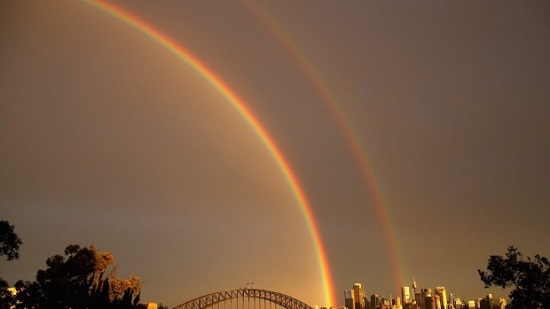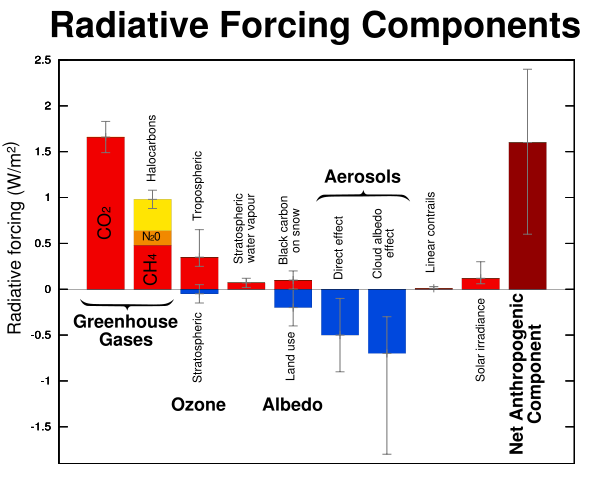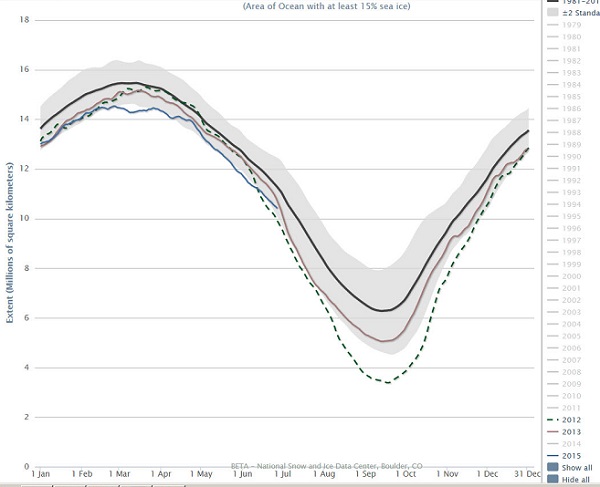1. Business, investor, environment, research and social groups look for climate consensus before Paris
- Business, investor, environment, research and social groups have formed an unprecedented alliance to establish common ground on which the climate debate can be conducted, as the Abbott government finalises the position it will take to Paris climate talks later in the year.
The Australian Industry Group, the Business Council of Australia, Investor Group on Climate Change, the Australian Aluminium Council and the Energy Supply Association of Australia have joined forces with the Australian Conservation Foundation, WWF Australia, the Australian Council of Social Service and the Australian Council of Trade Unions to set down some basic markers on climate policy which they hope will allow for future political consensus on the issue.
The new grouping is to be called the Australian Climate Roundtable. It has endorsed the 2°C limit and “eventually reducing net emissions to zero or below”.
The AFR decorates such a story of hope and good sense with a rainbow over the harbour bridge:

2. Producing hydrogen from water
Hydrogen has long been promoted as an emissions-free alternative to gasoline. Despite its sustainable reputation, most commercial-grade hydrogen is made from natural gas, a fossil fuel that contributes to global warming. As an alternative, scientists have been trying to develop a cheap and efficient way to extract pure hydrogen from water.
Stanford University scientists have invented a low-cost water splitter that uses a single catalyst to produce both hydrogen and oxygen gas 24 hours a day, seven days a week. The process works at room temperature with 82% efficiency.
3. Pope Francis recruits Naomi Klein in climate change battle
Naomi Klein is ‘surprised but delighted’ to join a top cardinal and others in a high-level environment conference at the Vatican.
Actually a press conference with high profile speakers is being held the day before the conference itself. From the press release about the press conference, the speakers are:
- • H.E. Cardinal Peter Turkson: President of the Pontifical Council for Justice and Peace;
• Ms. Naomi Klein: Author. Latest publication: “This Changes Everything” (Una rivoluzione ci salverà);
• Prof. Ottmar Edenhofer: Co-Chair of the Intergovernmental Panel on Climate Change (IPCC).
• Mr. Bernd Nilles: CIDSE Secretary General.
Naomi Klein is a fierce criticism of capitalism. It seems there is a meeting of minds between her and the Pope in this regard. Also in giving developing countries a greater voice.
- Several thousand demonstrators from various faiths marched through Rome to the Vatican to demand action on climate change in light of Pope Francis’ recent call to action.
The crowd was comprised of Catholics, Protestants, Buddhists, Hindus, Jews and Muslims.
4. Solar minimum would not hold off climate change
But it could bring colder winters to the US and Europe.
Solar activity varies over an 11-year cycle, but there are also longer variations. Activity has been falling so rapidly that there is now a 15 to 20% chance of reaching a new Maunder Minimum, experienced in the 17th century. If so global warming would only be slowed by a few years, not really of significance.
This graph from the 2007 IPCC report shows solar forcing in context:

In the 2013 IPCC report the solar factor is even more minuscule, but still positive. However, the graph is more complex, so I used the 2007 one to indicate the relativities.
5. Climate change and health
The Lancet Commission has examined the threat posed to public health by climate change. The effects are positive and negative so you have a choice in what you emphasise.
The ABC emphasises the positive:
- While the increased incidence of natural disasters clearly poses a potentially catastrophic risk, the report suggests burning less fossil fuels can reduce the rate of respiratory disease, and more active transport, like walking and cycling, can impact on obesity, diabetes, and coronary heart disease.
Carbon Brief headlines the positive, but also tells us:
- The impacts of climate change on human health are all-pervading. Small risks can interact to produce larger-than-expected chances of catastrophic outcomes, the report notes.
As well as the direct effects of rising temperatures on heat stress, floods, drought and other extreme weather, climate change increases air pollution, alters the spread of disease and raises the risk of food insecurity, malnutrition, migration and conflict.
The positive story actually represents an opportunity to be grasped in climate mitigation. The chair of the Commission spoke to the Financial Times (paywalled) in terms of a current “emergency”.
6. Arctic Sea ice
Having just passed the summer solstice it is appropriate to check out the progress of melting in the Arctic Sea. You can do this roughly speaking from the NSIDC site.
I’ve taken a screen shot of the interactive graph to show more complexity. The black line is the sea ice extent averaged from 1981 -2010. The dotted line is the record year of 2011. The purplish line is 2013. 2014 was similar. The blue line is 2015 to date.

We seem to be heading into safe territory, but Neven at the Arctic sea Ice Blog goes into gruesome detail and says appearances can be deceptive. In short there has been a lot of pooling, which creates momentum in melting, and sea ice area has been declining faster than sea ice extent.
Put simply, sea ice extent is the area covered by a Swiss cheese including the holes, whereas area measures only the cheese and not the holes.
Extent will always be bigger than area, but when area drops faster extent is likely to follow. Neven believes:
- 2015 will surpass rebound years 2013 and 2014, but whether it can come close to the top 3 years (2007, 2011 and 2012) is very much up in the air.
In case you are wondering, Antarctic winter ice is very healthy indeed according to NSIDC.


Brian: The graph you showed uses 15% ice cover as the dividing line for defining ice extent. It is a bit out of date with 2015 ice extent well behind record year 2012 extent.
However, 2012 surged following heavy storms in the arctic that broke up ice. There is still along way togo before the minimum is reached.
John, 15% ice cover seems standard. Do you ever see anything else?
I agree it’s to early to predict. In 2011 the big dip started in earnest in August.
15% is standard but you can have a lot of open water before ice gets as low as this.
Having said that the picture of ice extent does not look as though the ice is on the verge of a widespread loss of ice cover.
This ” First Ever Tropical Cyclone in July !” that ABC radio has been promoting ( every hour ) is easily debunked rubbish.
Unfortunately the gullible will hold this nonsense up as proof of climate change without an ounce of scepticism.
John, neven’s post suggests that there is quite a lot of sparse ice within the area covered by the ‘extent’, not just fraying around the edges. So largish areas could melt quite quickly.
Jumpy, it’s a named cyclone and the first time in July. How is that “rubbish” that needs debunking?
I haven’t heard anyone suggest that it proves climate change. That’s been proven ages ago!
Go on then Jumpy, debunk it.
Those interested in the whole story (not Jumpy’s mangled version) should look here.
zoot
I said
, did I not?
Go HERE and clicky on “*Database of past tropical cyclone tracks (Last updated on 2015-07-01 )*”
Despite the many, many omissions of detail there are more. ( you mangled my comment )
This from your link “Australia has only had one other officially declared July cyclone, which formed off Western Australia in 1996.” is untrue.
Jumpy, the source for the story run by ABC (radio and TV), Fairfax, and for all I know, Newscorpse is the Bureau of Meteorology so you really need to get your knickers in a twist about them stating “”We’ve never had a July tropical cyclone in the Queensland region before”.
I followed your link and I couldn’t find any July cyclones off the eastern coast.
Please help an old duffer and tell me when they occurred.
zoot
….sigh….
The story on my local ABC radio had no mention of ” Queensland region ” only Australia and said ” “first and only ”
I heard it 7 times so I’m pretty sure, did you hear it ?
Jumpy, I hope you have complained loud and long to your local ABC radio station because they obviously screwed up.
If you ask nicely they might even provide you with a recording of the offending item (news wasn’t it?) so you can complain to the ACMA.
I agree that this sort of sloppy reporting should not be allowed.
In fact, I’m using your experience to call on my local MP to increase funding for the ABC so that the staff may be better trained. This cannot continue!
Haven’t heard much from UNESCO about China ( those environmental guardians ,with the token renewbals and all ) treatment of reefs, hmm…..
http://www.abc.net.au/news/2015-07-02/china-airstrip-in-south-china-sea-nearly-finished/6589460
zoot
No, sell it and save Billions.
Please forgive me if I’m wrong Jumpy, but I seem to recall you mentioned living in or near Mackay.
If you do, according to the ABC website your local radio takes a news feed from 612 ABC Brisbane which carried this story on Tuesday. I presume most regional areas would be in the same boat, particularly with the budget cuts over the years.
So ABC radio was getting it right a day before you heard them totally screw the pooch. They must have had a work experience producer on Wednesday.